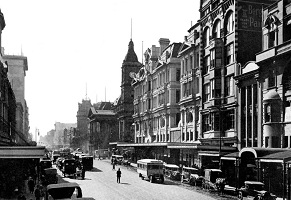Which parts of Australia roared loudest in the roaring 20s? Thanks to the ABS kindly publishing old Australian year books on their website, we can see how Australia’s population was distributed in the long lost past.

Of particular interest is the 1924 edition of the year book, which is one of the few early editions that publishes Census population numbers for Local Government Areas (LGAs), thereby enabling us to make direct small(ish) area comparisons to where people live today.

At the 1921 Census, Australia’s population was 5.44 million, roughly equivalent to Victoria’s population in 2010.
Sydney, then and now our largest city, had 981,000 residents.
The first thing that stands out from the 1921 population distribution is the importance of non-metropolitan Australia. Melbourne for example comprised merely 52% of Victoria’s population compared to 74% in 2010. Adelaide comprised 53% of South Australia’s population against 73% in 2010. Brisbane’s share of Queensland’s population – 29% in 1921 and 45% in 2010.
But it’s at the LGA level where things get interesting (well for me anyway). In 1921, there were only two LGAs in Australia with more than 100,000 residents and they were, can you guess? Sydney and Melbourne. This contrasts with 73 LGAs with more than 100k in 2010.
The City of Sydney’s 1921 population is particularly impressive when you consider much of today’s City of Sydney (Redfern, Glebe, Waterloo, Erskineville etc) were separate municipalities and not included in this number.
Only three municipalities were between 50,000 and 100,000. Perth, Prahran and Randwick. Only Randwick (50,800 in 1921) exists today on something approximating its 1921 boundaries having a 2010 population of 133,000, which puts it in 50th place in the 2010 list of LGAs by population.
As you would expect, it is what are now inner suburban areas (then outer suburban areas) that have the highest populations in 1921. North Sydney, South Melbourne, Brunswick, Hobart, Richmond (Vic), Brisbane (pre merger), Marrickville and Caulfield all have 1921 populations above 40,000. Many of these areas have declined in population as industry moved into inner suburban areas and average household sizes declined considerably.
In the post war years, what had been rural Shires on the fringes of our major cities swamped these inner city LGAs in population terms. Inner city population decline is perhaps best illustrated by the City of Adelaide with 39,600 residents in 1921 and 19,900 in 2010.
Local government restructuring since the 1920s makes direct comparisons between 1921 and now difficult. Of the 20 largest LGAs in Australia by population in 2010, only Bankstown City in Sydney’s south west covers a comparable area to that of 1921. Its 2010 population of 189,000 compares with 10,700 in 1921. Other assorted direct comparisons (1921 pop, 2010 pop) are as follows:
Going up:
Canterbury (NSW) 37,600 – 145,700
Boroondara (Vic) then Hawthorn, Kew, Camberwell 70,400 – 169,500
Fremantle (WA) then Fremantle, North Fremantle 21,100 – 28,600
Going down:
Broken Hill (NSW) 26,300 – 19,800
Leichhardt (NSW) then Balmain, Leichhardt, Annandale 74,100 – 55,600
Finally, a look at the Top 10 list for each time period is an interesting history lesson in itself:
Top 10 LGAs in Australia by population 1921
Sydney (NSW) – 104,153
Melbourne (Vic) – 103,251
Perth (WA) – 64,166
Randwick (NSW) – 50,841
Prahran (Vic) – 50,290
North Sydney (NSW) – 48,438
South Melbourne (Vic) – 46,873
Brunswick (Vic) – 44,484
Hobart (Tas) – 43,589
Richmond (Vic) – 43,174
Top 10 LGAs in Australia by population 2010
Brisbane (Qld) – 1,067,279
Gold Coast (Qld) – 527,828
Moreton Bay (Qld) – 382,280
Sunshine Coast (Qld) – 330,934
Blacktown (NSW) – 307,816
Logan (Qld) – 282,673
Casey (Vic) – 255,659
Sutherland Shire (NSW) – 220,835
Greater Geelong (Vic) – 220,068
Wollongong (NSW) – 203,487
If you enjoyed this article, visit our website at id.com.au or sign up to get updates via email and twitter (above), and feel free to share it.











